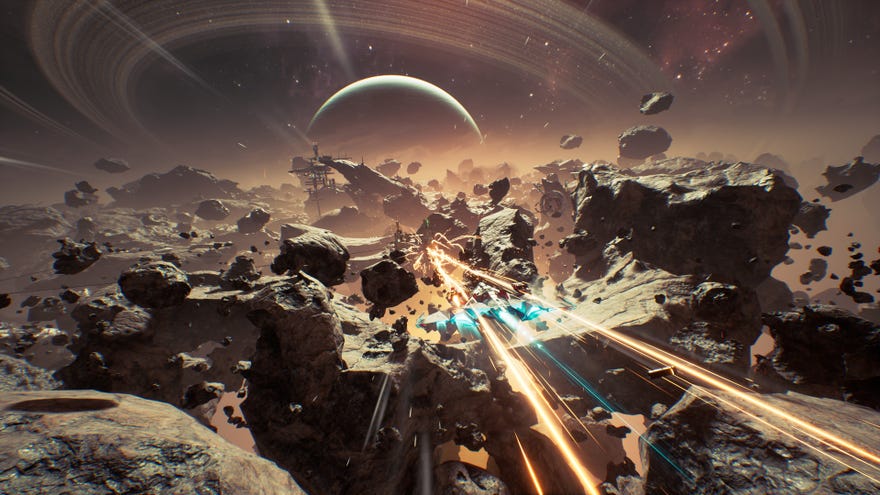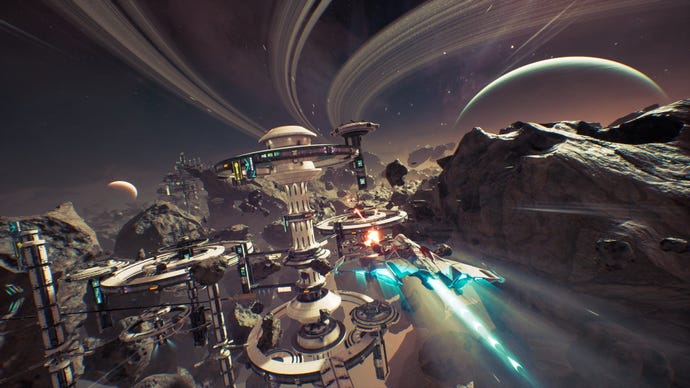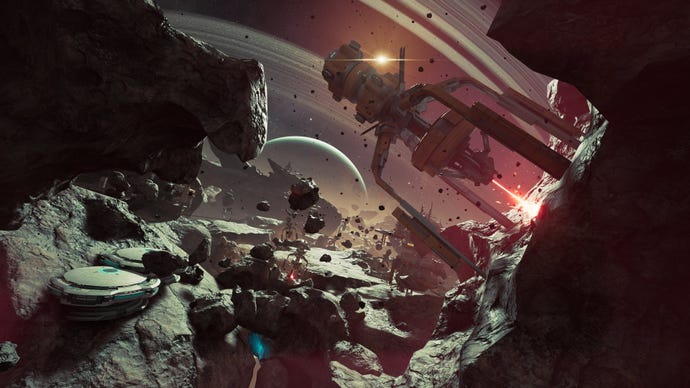HomeFeatures
How Embracer’s cuts killed a potential Red Faction sequel and gutted a promising studioThe exclusive inside story of Chorus developers Fishlabs, from Project Black to Project White
The exclusive inside story of Chorus developers Fishlabs, from Project Black to Project White
Image credit:Plaion
Image credit:Plaion

A scene from Chorus, Fishlabs’s well-regarded 2021 space sim. |Image credit:Plaion

Wecovered the November layoffs, and in the wake of that report, a former employee of Fishlabs got in touch with me to discuss life at the studio leading up to their departure. Following that conversation, I approached several other departed Fishlabs staff to corroborate what I’d heard, all of whom spoke on condition of anonymity. This article is the result, a rare insider account of a studio who, according to sources, were prosperous and pushing into exotic new territory when the axemen came knocking. Embracer and Plaion were approached for comment about this story, but did not reply.
Founded in 2004, and sold to Koch Media in 2013, Fishlabs are the creators of the Galaxy On Fire space sims for mobile, some of which have beenported to PC. In 2021, the developers opened a new chapter with the release of the eerie and charismatic Chorus, which Sam Greerpraisedfor its “over-the-top world and tone with slick dogfighting”. My sources said that Chorus was a profitable release for Fishlabs, despite not meeting the expectations of Embracer management, and that this success was the catalyst for the studio’s transformation into a creator of console and PC games.
In June 2023, Fishlabs had two in-house projects. Project White was the “side hustle”, a team devoted to pitching games based on other intellectual properties that Embracer owned. Project Black - the “shining star” - was an original game which sources say began development in 2021. In-house projects aside, Fishlabs also operated a cross-development team taking on work for other studios, such as Powerwash Simulator developer Futurlab.
Chorus may be a space shooter, but it has an eye for solid terrain - you can imagine this team making a great on-foot science-fantasy adventure. |Image credit:Plaion


Project Black was a troubled endeavour. In development for roughly two years, the game had lovely art, but my sources characterised its design as undecided and lacking cohesion, partly because it didn’t have a single game director but a board of directors. It had a flat operational structure, where ideas came from all over. This meant that everybody felt a sense of autonomy, but it could also be the basis for confusion and delays, as teams blindsided each other with suggestions.
The rest of the Project Black team were split up between the company’s other projects. Around half joined the company’s cross-dev team, working on external projects, while the other half joined Project White. Crucially, Fishlabs were able to retain their German government funding and transfer it to Project White.


Embracer announcedthe closure of Red Faction’s original creators, the wonderful Volition Inc, on 31st August 2023. At the time, the studio’s former parent group Deep Silver thanked Volition “for their unforgettable work onSaints Rowand Red Faction, whose IPs will live on at Plaion”. As you might expect, my sources expressed mixed feelings about pitching a new game in a series whose creator studio had just been shuttered, with one describing it as “ghoulish”.
The pitch made sense to studio members, nonetheless. Fishlabs had ample experience in science fiction, and as a new entry in a well-known, proven series, the Red Faction game would surely be safe against cancellation. Sources added that the Red Faction universe was especially appealing to Fishlabs staff in the wake of Project Black’s demise and amid the wider news about Embracer’s butchering of their studios. Red Faction, after all, began life as a story of working people fighting corporate injustice.

While the transferred Project Black staff carried out wider research on Red Faction, the existing Project White team worked on a “visual prototype” or “fake trailer” created with Unreal Engine 5, to present to Plaion. At this early stage, there were many ideas about the project’s direction, some of which would likely have been abandoned as the game evolved. But the basic ambition was to create something similar to 2009’s open world third-person Red Faction: Guerrilla, in which you can tear down whole bases with a sledgehammer, while ignoring the events of the under-loved fourth Red Faction game,Red Faction: Armageddon. “We were trying to look at what did Guerrilla do right, what did Armageddon do wrong, and how can we marry the two and continue on with it,” one source explained.
While the game was envisaged as a “safe sequel” with a familiar emphasis on wrecking buildings, members of the Project White team also wanted to create a more open-ended play experience - closer to an immersive sim, perhaps, with opportunities for stealthy infiltration and player disguises alongside vehicle customisation. There were pie-in-the-sky aspirations to create an extremely reactive setting with dynamic dialogue, in which characters would comment on your methods of completing quests.

Even given the grief and anger over Project Black’s cancellation and the subsequent layoffs, sources claimed that morale on the Red Faction project was good. Partly, this reflected the natural camaraderie born of sharing a painful experience. But many at Fishlabs also felt that the worst might be over. According to several people, studio leadership made sincere assurances that Fishlabs were safe from further cuts because they had independent government funding, and were making money for Embracer through their cross-dev team. Lessons had also been learned from the problems of Project Black’s development. The Red Faction project had a clearer hierarchy, with a game director and an art director working closely together. There was less ambiguity about the game’s direction because, again, Red Faction is an established narrative universe with many precedents to build on.
During the week of 20th November, there was another internal vote on the Red Faction project’s future. The vote was split 50-50, which meant that the Red Faction game was immediately cancelled. In the wake of the cancellation, Fishlabs studio leadership were told to lay off almost everyone not attached to an active game project. The crucial email came on a Friday, with Fishlabs bosses then working over the weekend to draw up a list of people who would be let go.
Early the next week, there was a surprise all-hands meeting, encompassing on-site staff and remote workers. If you have any experience of being mass laid off, you’ll know that a surprise all-hands meeting is seldom great news. But many staff went into the meeting nonetheless with high hopes. People had been told that Plaion and Embracer liked the Red Faction game, and some assumed the meeting would bring confirmation that it had been greenlit for full development.
Even today, Volition’s Red Faction Guerrilla is legendary for its terrain destruction systems. |Image credit:Deep Silver

When staffers entered the meeting, however, it was obvious what was coming. “You could see that both the company chiefs had been crying a lot, and there was a representative from Plaion there as well,” one person told me. Around 50 people were laid off, cutting across departments - level design, narrative, game design, programming, audio, art and animation. As with the previous cuts, a handful of staff were transferred to Fishlabs' cross-development team. Even as they announced the layoffs, studio development director Tobias Severin and managing director Stefan Beier both declared that they would step down.
In gutting Fishlabs, Embracer have done a colossal injury to one of the industry’s kinder creative communities. My sources painted the picture of a studio with a transparent and supportive working culture, in which the leadership were visible and involved day-to-day, staff trusted each other, people weren’t guilt-tripped for taking time off, and everybody felt like they had a chance to contribute in a meaningful way.
It wasn’t paradise: there were conflicts and tricky personalities, but in general, all my contacts looked back on their experiences at the company very fondly. People also characterised Fishlabs as a studio on the make, following the warm reception for Chorus. Project Black was supposed to be the next big pivot, a step beyond the space sim genre that might have opened the way for all kinds of game concepts, whether original in-house creations or licensed adaptations.
Elite Cinematic : Prototype for Project BlackWatch on YouTube
Elite Cinematic : Prototype for Project Black

Above all, Fishlabs was a studio whose leaders were prepared to fight for their staff. While it’s hard to go into detail without breaking confidentiality, several sources told me that the studio’s management and especially Severin and Beier worked hard to save positions and soften the blow for those leaving Fishlabs, both following Project Black’s cancellation and after the rejection of the Red Faction pitch.
The November layoffs were more chaotic. Some people had recently moved to Germany, meeting part of the relocation costs themselves. Others were still on probation, meaning they were strictly speaking entitled to only two weeks severance under German law. Certain team members were based in different countries, which affected their severance packages. According to several people, however, Fishlabs leadership and the company’s embattled HR team were able to arrange a better deal in some cases.
Concluding each interview, I asked my sources whether they agreed with the now widely-reported tale behind Embracer’s need to “restructure” - that they were banking everything on an eventual blockbuster investment deal such as the reported Savvy Games cash injection to offset their debts after so many acquisitions. All broadly echoed this narrative. I also asked for general thoughts on what Embracer were like to work under. Sources described the parent company as “hands-off”, with most communication arriving through Plaion, and not much communication with other studios under Embracer’s umbrella. While the company was aloof, this is hardly unusual for parent organisations, and nobody had any complaints about Embracer’s overall management prior to the beginning of Project Phoenix.
Chorus is on some level a horizontal open world, with environments that feel like huge arenas full of floating structures. |Image credit:Plaion
